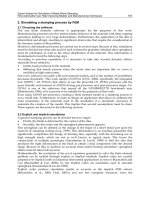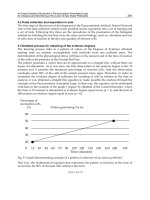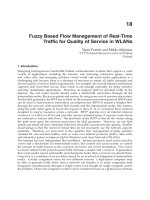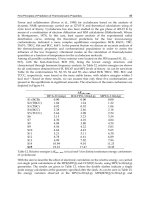Complex Robotic Systems - Pasquale Chiacchio & Stefano Chiaverini (Eds) Part 3 pot
Bạn đang xem bản rút gọn của tài liệu. Xem và tải ngay bản đầy đủ của tài liệu tại đây (728.44 KB, 15 trang )
22
Chapter 1. Multi-arm
robot
systems: A survey
1.7.2 Slip detection and robust holding
Cooperating multiple robots experience slip when grasps on the object are
defined by the internal forces developed due to each robot. Such manip-
ulations without physical grasps have got many constraints like friction
between a robot's finger-tip and the object, and the friction cone defined
due to it. A contact-point slip is evident if any of the constraints is over-
looked. This slip causes not only manipulation errors but also a failure
of system control. However, if this slip or its effects are compensated just
after its occurrence, then a successful manipulation is possible even in an
enhanced workspace.
Since all the robotic systems normally have got some conventional and
cheap sensors which can give sufficiently rich informations to localize the
end-point tips, it is quite beneficial to utilize only these sensors to detect
and compensate the contact-point slips. The basic tools in this approach
are some very simple laws based on geometrical analysis of the mesh of
links developed by inter-connecting all the contact-points. The main tool
is a slip indicator Si, which is defined as
= fi I zxR,j I (1.4s)
j=l
wherei = j = 1, 2, 3, ,n is the contact-point number.
ARij
is the
change in an inter-contact link between ith and jth contact-points after a
slip occurs. Si sums up all these absolute changes for the links having their
one end at ith contact-point.
Surely Si will have a maximum value for the contact-point which actu-
ally slips. For a few cases of two or more simultaneous slips, a recursion
in the above procedure results in correct detection of all the slipped finger-
tips unless more than half of them experience slips simultaneously. Once
slipped contact-points have been detected, it needs a little knowledge of
geometry, and probably some checks, to calculate the amounts by which
each
contact-point
slips, taking the unslipped contact-points as reference
and some other fixed points on the object's surface, regarded as landmarks.
An illustration for a four-arm robot system cooperating to manipulate
a geometrically regular shaped object is shown in Figure 1.16. The dis-
tances of the robot's finger-tips from the nearest landmarks are defined as
c~i. These distances are very helpful in determining the physical amounts
of slips geometrically. The control structure which takes into account the
phenomenon of slip is shown in Figure 1.17. This control method gener-
ates the actuator force commands for a proper force distribution between
all the arms to generate a resultant external force corresponding to the
1.7. Advanced topics
23
~ o~ l q
L
Figure 1.16: Four-arm robot system cooperating at an object.
desired manipulation along with maintaining certain fixed internal forces
responsible for grasps.
The experimental results obtained using the control algorithm of Fig-
ure 1.17 on the system of Figure 1.16 are shown in Figures 1.18-1.21. For
a manipulation with no slip, M1 the values of c~ should remain constant.
But as a finger slips, the new values of a~ are calculated after an execution
of the slip detection Mgorithm for all manipulating arms. The results show
that a successful object manipulation was possible even after two contact-
points changed their positions due to occurrence of slips at different time
intervals.
A sensor-based approach is to employ a vision-tracking system for slip
detection. One way is to track the contact-points and whenever there occurs
a slip, its amount is known by making a comparison with previously tracked
video frames, while the other way is to track the object being manipulated;
in this way the vision-tracking system acts as a sensor for the actual posture
of the object. This approach should work well as a sensor for object's
posture is present in the main control loop, but the main problem is the
slow tracking speed which is dependent on video scanning speed. Moreover,
another problem is the high cost of this system which makes the overall
system a cost non-effective one.
24
Chapter 1. Multi-arm robot systems: A survey"
(
~,,,,,,on l
+ ;L ~,
i c.,,,,,=Ex,o,.,,,I ~ I t,.
Figure 1.17: Control algorithm considering slip detection/compensation.
X
t-
O
f,o
0
12.
0.05
0
-0.05 I_
0
Cur
Ref
i i
1 2 3
Time [s]
Figure 1.18: Experimental results: Position along x.
1.7. Advanced
topics
25
K
>-
.o
o0
0
0.05
-0.05
Cur
Ref
i
0 1 2 3
Time [s]
Figure 1.19: Experimental results: Position along y.
20
10
¢.
.o 0
e-
._
-10
Cur
Ref
-2O
I i
0 1 2 3
TAme [s]
Figure 1.20: Experimental results: Orientation.
26
Chapter 1. Multi-arm
robot
systems: A survey
0.06
0.05
0.04
E
0.03
t-
O.
< 0.02
0.01
Alpha_l
Alpha_2
Alpha_3
Alpha_4
:/:!:::::::~ ~ =
j
0
I i
0 1 2
Time [s]
3
Figure 1.21: Experimental results: a.
1.8 Conclusions
In this chapter, we have presented a general perspective of the state of the
art of multi-arm robot systems. First, we presented a historical perspective
and, then, gave fundamentals of the kinematics, statics, and dynamics of
such systems. Definition of task vectors highlighted the results and gave a
basis on which cooperative control schemes such as hybrid position/force
control, load sharing control, etc. were discussed systematically. We also
discussed practical implementation of the control schemes and reported suc-
cessful implementation of hybrid position/force control without using any
force/torque sensors but with exploiting motor currents. Friction compen-
sation techniques are crucial for the implementation. Lastly, we presented a
couple of advanced
topics
such as cooperative control of multi-flexible-arm
robots, and robust holding with slip detection. In concluding this chapter,
we should note that application of theoretical results to real robot systems
is of prime importance, and that efforts in future research will be directed in
this direction to yield stronger results. Advanced topics for future research
will include kinematics for more sophisticated tasks [42] and decentralized
control [43].
REFERENCES 27
Acknowledgements
The author records acknowledgments to Prof. Kazuhiro Kosuge, Dr. Mikhail
M. Svinin, Mr. Yuichi Tsumaki, Mr. Khalid Munawar, Mr. Yoshihiro Tanno,
and Mr. Mitsuhiro Yamano who helped him in preparing this chapter.
References
[1]
S. Fujii and S. Kurono, "Coordinated Computer Control of a Pair of
Manipulators," in Proc. 4th IFToMM World Congress, Newcastle
upon Tyne, England, September 1975, pp. 411-417.
[2]
E. Nal~no, S. Ozaki, T. Ishida, and t. Kato, "Cooperational Control
of the Anthropomorphous Manipulator 'MELARM'," in Proc. 4th
Int. Syrup. Industrial Robots, Tokyo, Japan, November 1974, pp.
251-260.
[3]
K. Talcase, H. Inoue, K. Sato, and S. Hagiwara, "The Design of an
Articulated Manipulator with Torque Control Ability," in Proc. 4th
Int. Syrup. Industrial Robots, Tokyo, Japan, November 1974, pp.
261-270.
[4] T. Ishida, "Force Control in Coordination of Two Arms," in Proc.
5th Int. Conf. on Artificial Intelligence, 1977, pp. 717-722.
[5]
[6]
[7]
S. Kurono, "Cooperative Control of Two Artificial Hands by a
Mini-Computer," in Prepr. 15th Joint Conf. on Automatic Control,
November 1972, pp. 365-366, (in Japanese).
A. J. Koivo and G. A. Bekey, "Report of Workshop on Coordi-
nated Multiple Robot Manipulators: Planning, Control, and Ap-
plications," IEEE J. of Robotics and Automation, vol. 4, no. 1, pp.
91-93, 1988.
P. Dauchez and R. Zapata, "Co-Ordinated Control of Two Cooper-
ative Manipulators: the Use of a Kinematic Model," in Proc. 15th
Int. Syrup. Industrial Robots, Tokyo, Japan, September 1985, pp.
641-648.
[8]
N. H. McClamroch, "Singular Systems of Differential Equations as
Dynamic Models for Constrained Robot Systems," in Proc. 1986
IEEE Int. Conf. on Robotics and Automation, San Francisco, USA,
April 1986, pp. 21-28.
28
Chapter 1. Multi-arm robot systems: A survey
[9] T. J. Tam, A. K. Bejczy, and X. Yun, "New Nonlinear Control
Algorithms for Multiple Robot Arms," IEEE Trans. on Aerospace
and Electronic Systems, vol. 24, no. 5, pp. 571-583, 1988.
[10] S. Hayati, "Hybrid Position/Force Control of Multi-Arm Cooper-
ating Robots," in Proc. 1986 IEEE Int. Conf. on Robotics and Au-
tomation, San Francisco, USA, April 1986, pp. 82-89.
[1I] M. Uchiyama, N. Iwasawa, and K. HM(omori, "Hybrid Posi-
tion/Force Control for Coordination of a Two-Arm Robot," in Proc.
1987 IEEE Int. Conf. on Robotics and Automation, Raleigh, USA,
March 1987, pp. 1242-1247.
[12] M. Uchiyama and P. Dauchez, "A Symmetric Hybrid Position/Force
Control Scheme for the Coordination of Two Robots," in Proc. 1988
IEEE Int. Conf. on Robotics and Automation, Philadelphia, USA,
April 1988, pp. 350-356.
[13] M. Uchiyama and P. Dauchez, "Symmetric Kinematic Formulation
and Non-Master/Slave Coordinated Control of Two-Arm Robots,"
Advanced Robotics: The International .Journal of the Robotics So-
ciety of Japan, vol. 7, no. 4, pp. 361-383, 1993.
[14 t I. D. Walker, R. A. Freeman, and S. I. Marcus, "Analysis of Motion
and Internal Force Loading of Objects Grasped by Multiple Coop-
erating Manipulators," Int. J. of Robotics Research, vol. 10, no. 4,
pp. 396 409, 1991.
[15] R. G. Bonitz and T. C. Hsia, "Force Decomposition in Cooperating
Manipulators Using the Theory of Metric Spaces and Generalized
Inverses," in Proe. 1994 IEEE Int. Conf. on Robotics and Automa-
tion, San Diego, USA, May 1994, pp. 1521-1527.
[16] D. Williams and O. Khatib, "The Virtual Linkage: A Model for
Internal Forces in Multi-Grasp Manipulation," in Proc. 1993 IEEE
Int. Conf. on Robotics and Automation, Atlanta, USA, May 1993,
pp. 1025-1030.
[17] M. Uchiyama and Y. Nakamura, "Symmetric Hybrid Position/Force
Control of Two Cooperating Robot Manipulators," in Proc. 1988
IEEE Int. Workshop on Intelligent Robots and Systems, Tokyo,
Japan, November i988, pp. 515-520.
[18] J. T. Wen and K. Kreutz-Delgado, "Motion and Force Control of
Multiple Robotic Manipulators," Automatica, vol. 28, no. 4, pp.
729-743, 1992.
REFERENCES 29
[19] V. Perdereau and M. Drouin, "Hybrid External Control for Two
Robot Coordinated Motion," Robotica, vol. 14, pp. 141 153, 1996.
[20]
K. Kosuge, M. Koga, and K. Nosaki, "Coordinated Motion Control
of Robot Arm Based on Virtual Internal Model," in Proc. 1989
IEEE Int. Conf. on Robotics and Automation, Scottsdale, USA,
May 1989, pp. 1097-1102.
[21]
M. Koga, K. Kosuge, K. Furuta, and K. Nosaki, "Coordinated Mo-
tion Control of Robot Arms Based on the Virtual Internal Model,"
IEEE Trans. on Robotics and Automation, vol. 8, no. 1, pp. 77-85,
1992.
[22]
D. E. Orin and S. Y. Oh, "Control of Force Distribution in Robotic
Mechanisms Containing Closed Kinematic Chains," Trans. ASME,
J. of Dynamic Systems, Measurement, and Control, vol. 102, pp.
134-141, 1981.
[23]
Y. F. Zheng and J. Y. S. Luh, "Optimal Load Distribution for Two
Industrial Robots Handling a Single Object," in Proe. 1988 IEEE
Int. Conf. on Robotics and Automation, Philadelphia, USA, April
1988, pp. 344-349.
[24]
M. Uchiyama, "A Unified Approach to Load Sharing, Motion De-
composing, and Force Sensing of Dual Arm Robots," Robotics Re-
search: The F~fth International Symposium, Edited by H. Miura
and S. Arimoto, The MIT Press, pp. 225-232, 1990.
[25]
M. A. Unseren, "A New Technique for Dynamic Load Distribution
when Two Manipulators Mutually Lift a Rigid Object. Part i: The
Proposed Technique," in Proc. Fi~t World Automation Congress
(WAC '94), Maui, USA, August 1994, vol. 2, pp. 359-365.
[26]
M. A. Unseren, "A New Technique for Dynamic Load Distribu-
tion when Two Manipulators Mutually Lift a Rigid Object. Part 2:
Derivation of Entire System Model and Control Architecture," in
Proc. First World Automation Congress (WAC '94), Maui, USA,
August 1994, vol. 2, pp. 367-372.
[27]
M. Uchiyama and T. Yamashita, "Adaptive Load Sharing for Hy-
brid
Controlled Two Cooperative Manipulators," in Proc. 1991
IEEE Int. Conf. on Robotics and Automation, Sacramento, USA,
April 1991, pp. 986-991.
30
[2s]
[29]
[30]
[31]
[32]
[33]
[34]
[35]
[36]
Chapter 1. Multi-arm
robot
systems: A survey
M. Uchiyama and Y. Kanamori, "Quadratic Programming for
Dextrous Dual-Arm Manipulation," in
Robotics, Mechatronics
and Manufacturing Systems, Trans. IMACS/SICE Int. Syrup. on
Robotics, Mechatronics and Manufacturing Systems, Kobe, Japan,
September 1992,
Elsevier Science Publishers B.V. (North-Holland),
pp. 367-372, 1993.
M. Uchiyama, X. Delebarre, H. Amada, and T. Kitano, "Optimum
Internal Force Control for Two Cooperative Robots to Carry an
Object," in
Proc. First World Automation Congress (WAC '9~),
Maui, USA, August 1994, vol. 2, pp. 111-116.
H.
Inoue, "Computer Controlled Bilateral Manipulator,"
Bul.
JSME,
vol. 14, no. 69, pp. 199-207, t971.
M. Uchiyama, T. Kitano, Y. Tanno, and K. Miyawaki, "Coopera-
tive Multiple Robots to Be Applied to Industries," in
Proc. World
Automation Congress (WAC '96),
Montpetlier, France, May 1996,
vol. 3, pp. 759-764.
Y. F. Zheng and M. Z. Chen, "Trajectory Planning for Two Ma-
nipulators to Deform Flexible Beams," in
Proc. 1993 IEEE Int.
Conf. on Robotics and Automation,
Atlanta, USA, May 1993, pp.
1019-1024.
M. M. Svinin and M. Uchiyama, "Coordinated Dynamic Control of
a System of Manipulators Coupled via a Flexible Object," in
Prepr.
4th IFAC Symp. on Robot Control,
Capri, Italy, September 1994,
pp. 1005-1010.
T. Yukawa, M. Uchiyama, D. N. Nenchev, and H. Inooka, "Stability
of Control System in Handling of a Flexible Object by Rigid Arm
Robots," in
Proc. 1996 IEEE Int. Conf. on Robotics and Automa-
tion,
Minneapolis, USA, April 1996, pp. 2332-2339.
D. Sun, X. Shi, and Y. Liu, "Modeling and Cooperation of Two-
Arm Robotic System Manipulating a Deformable Object," in
P~vc.
1996 IEEE Int. Conf. on Robotics and Automation,
Minneapolis,
USA, April 1996, pp. 2346-2351.
J S. Kim, M. Yamano, and M. Uchiyama, "Lumped-Parameter
Modeling for Cooperative Control of Two Flexible Manipulators,"
Asia-Pacific Vibration Conf. '97,
Kyongju, Korea, November 1997,
(to be presented).
REFERENCES 31
[37]
M. Yamano, J S. Kim, and M. Uchiyama, "Experiments on Co-
operative Control of Two Flexible Manipulators Working in 3D
Space," Asia-Pacific Vibration Conf. '97, Kyongju, Korea, Novem-
ber 1997, (to be presented).
[38]
M. Uchiyama and A. Konno, "Modeling, Controllability and Vi-
bration Suppression of 3D Flexible Robots," Robotics Research,
The Seventh International Symposium, G. Giralt and G. Hirzinger
(Eds), Springer, pp. 90-99, 1996.
[39]
K. Munawar and M. Uchiyama, "Slip Compensated Manipulation
with Cooperating Multiple Robots,"
36th IEEE CDC,
San Diego,
USA, December 1997, (to be presented).
[4o]
Y. Q. Dai, A. A. Loukianov, and M. Uchiyama, "A Hybrid Numer-
ical Method for Solving the Inverse Kinematics of a Class of Spatial
Flexible Manipulators," in Prve. 1997 IEEE Int. Conf. on Robotics
and Automation, Albuquerque, USA, April 1997, pp. 3449-3454.
[41]
M. Uchiyama, A. Konno, T. Uchiyama, and S. Kanda, "Devel-
opment of a Flexible Dual-Arm Manipulator Testbed for Space
Robotics," in Proc. IEEE Int. Workshop on Intelligent Robots and
Systems, Tsuchiura, Japan, July 1990, pp. 375-381.
[42]
P. Chiacchio, S. Chiaverini, and B. Siciliano, "Direct and inverse
kinematics for coordinated motion tasks of a two-manipulator sys-
tem," Trans. ASIDE J. of Dynamic Systems, Measurement, and
Control, vol. 118, pp. 691-697, 1996.
[43]
K. Kosuge and T. Oosumi, "Decentralized Control of Multiple
Robots Handling an Object," in Proc. 1996 IEEE/RSJ Int. Conf
on Intelligent Robots and Systems, Osaka, Japan, November 1996,
pp. 318-323.
Chapter 2
Kinematic manipulability
of general mechanical
systems
This paper extends the kinematic manipulability concept commonly used
for serial manipulators to general constrained rigid multibody systems. Ex-
amples of such systems include multiple cooperating manipulators, multiple
fingers holding a payload, multi-leg walking robots, and variable geometry
trusses. Explicit formulas for velocity and force manipulability ellipsoids
are derived and their duality explained. The concept of unstable grasp
and manipulable grasp are also extended and illustrated with examples.
It is then shown that manipulability can be significantly modified through
bracing with another arm. Finally, several methods for comparing manip-
ulability ellipsoids are developed which can be used in turn to optimize the
brace design.
2.1 Introduction
This paper considers the kinematic manipulability of general constrained
multibody systems. Such systems include a single articulated robot in
contact with the environment, a multi-finger hand (Figure 2.1), multiple
cooperative robots, and even a Stewart Platform (Figure 2.2). We first
present a general kinematic model which considers all degrees of freedom
and then imposes the constraints as Mgebraic conditions. Kinematic models
of multi-finger grasping and a 6-DOF Stewart Platform are used as illus-
33
34__ Chapter 2. Kinematic manipulabilitw of general mechanical systems
Jl
/
////J
i
rfff fff~ vffff
Figure 2.1: Two constrained manipulators in a load-sharing configuration.
A~
A4
cl~ ~3
Figure 2.2: A Stewart platform.
trative examples. Through the Principle of Virtual Force, we also derive
the general static force balance model which can be considered as a dual of
the differential kinematics.
We then extend the familiar single arm manipulability ellipsoid concept
first proposed in [1]. Characterization for both velocity and force ellipsoids
is presented. When applied to multiple cooperative arms employing a rigid
grasp or to multiple finger grasping, this work is closest to the work by
[2] and is also closely related to the past work by [3, 4]. We also extend
the important concepts of grasp stability and manipulability. We obtain
explicit characterization for both properties and present their physical in-
terpretation. As illustrations, we include a planar Stewart Platform, a full
6-DOF Stewart Platform, and a planar two-finger grasping example from
[3, 4].
2.2. Differential kinematics and static force model
35
We also consider the effect of bracing on manipulability, by using a ma-
nipulator as a mobile fixture. Finding the best location and grasp type for
a fixturing manipulator may be posed as a kinematic optimization problem,
but a metric must first be defined for the manipulability ellipsoid. Several
possible choices for ellipsoids metrics are stated and compared.
This paper is laid out in the following manner. We will first present
the differential kinematic and static force model of a general constrained
multiple-manipulator systems in Section 2.2. The velocity and force ellip-
soids, and extension of grasp stability and manipulability are presented in
Section 2.3. Section 2.4 presents a number of examples.
Terminology and Notation:
We shall use the term "spatial force" at a given
[ t°rque ] and the term "spatial velocity"
frame to mean the 6 x 1 vector of force '
[ angular vet°city ]. Given a
at a given frame to mean the 6 × 1 vector linear velocity
matrix G, we use G to either denote the annihilator of G (GG = 0) or the
transpose of the annihilator of
G T
(GG = 0). Which of the two cases will
be clear from the context.
2.2 Differential kinematics and static force
model
This section considers the differential kinematics and static force balance
of general rigid multibody systems. Multiple-finger grasping and a Stewart
Platform will be used as examples.
2.2.1 Differential kinematics
We consider a general mechanism subject to kinematic constraints. The
generalized coordinate (with the constraints removed) is denoted by 0. The
active joints' angles are denoted by 0~ and passive ones by 0p. We order
the angles so that 0T = [0F, 0T]. Consider a general constraint (written in
terms of the joint velocity vector)
Jc(t?)~ 0. (2.1)
Let the spatial velocity of the task frame be
VT = JT(8)~.
(2.2)
36
Chapter 2. Kinematic manipulability o[ general mechanical systems
Suppose that
Jc
(9) is full rank. Then ~ = Jc~, where jT is the annihilator
of jT. The task velocity can be written as
VT = JT Jc~.
(2.3)
The mechanism is singular if
JT.]C
loses rank; in other words, there are
some directions in
VT
that cannot be attained (but which can be attained
in other arm configurations).
As an example, consider the kinematic model of multiple fingers grasp-
ing a rigid payload. For each serial chain, the joint velocity vector is defined
as 0i, the arm tip spatial velocity is v +, and they are related by the arm
Jacobian Ji(0i):
v + =
We consider a single task frame attached to the constraining rigid body
(see Figure 2.1) whose spatial velocity is defined as
VT.
On the payload
side of the contact, the spatial velocity, v~-, is related to the task velocity
VT
by
[ , °]
v~- = AiVT
where A/ :
Lit x I
where
Lit
is the vector from the ith tip to the task frame. The relative
velocity at each contact is parameterized by a velocity vector Wi:
v + + HTW, = v~-
where the columns of H T are the directions where relative velocities at the
contact are allowed.
To write the multi-arm kinematics more compactly, we stack all the
vectors (e.g., 0i's are stacked into a single vector
Oa)
and block diagonal-
ize all the matrices (e.g., Ji's form the diagonal blocks of J), except for
A T
~ [
A T A T ]. Then the differential kinematic relationship can
be written as
v + + HTw = v-
v + = J~a
(2.5)
v- = AVT
Some examples of possible contacts are shown in Figures 2.3-2.6.
Defining ~p = W, we can represent the multi-finger kinematic model in
the general form as in (2.1)-(2.2):
A[ J HT
] 0p = 0 (2.6)
2.2. Differential kinematics and static force model
37
HTw =[hl¢
(6xl) (6xl)(lxl)
Figure 2.3: line contact (1 DOF rotation about h permitted).
.~w__ [o olPxl
,
khx hy_l Lvy_l
,
(6xl) (6x2) (2xl)
Figure 2.4: Sliding contact (2 DOF sliding along hx and
h u
permitted).
hx
Figure 2.5: Point contact
permitted).
HTw=
Io' ° jF!!l
hxh Vx
(6xl) (6x5) (5xl)
(5 DOF rotation, sliding along hx and hy
h~ (6xl) (6x3)(3xl)
Figure 2.6: Point contact with friction (3 DOF only rotation permitted).









